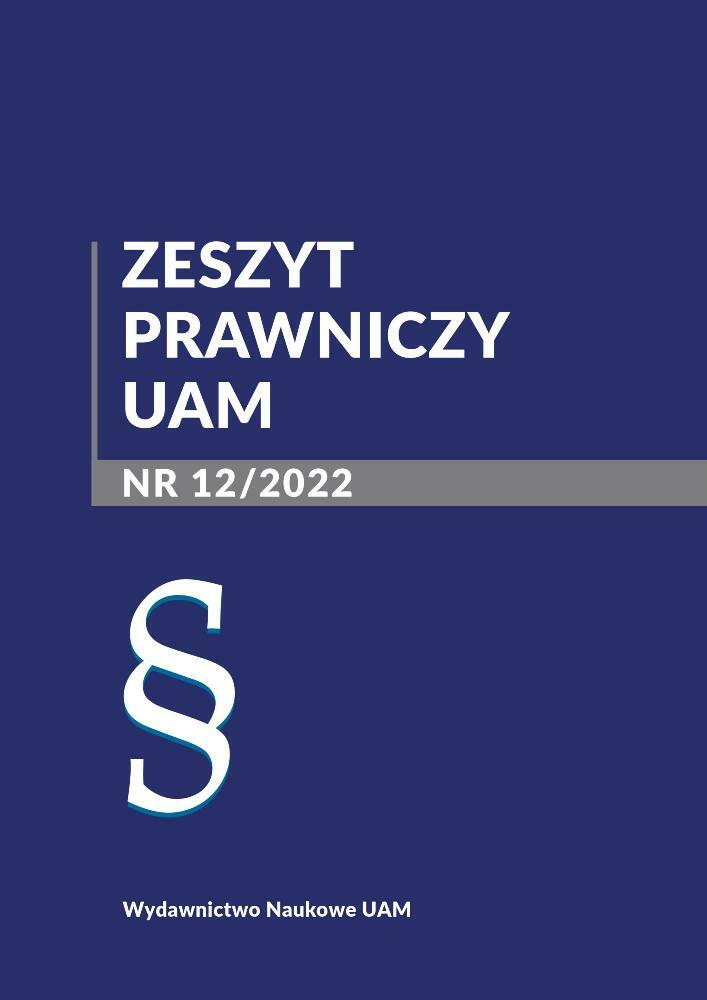Abstrakt
Celem artykułu jest przedstawienie problematyki łącznika miejsca zwykłego pobytu spadkodawcy na gruncie rozporządzenia Parlamentu Europejskiego i Rady UE z dnia 4 lipca 2012 r. w sprawie jurysdykcji, prawa właściwego, uznawania i wykonywania orzeczeń, przyjmowania i wykonywania dokumentów urzędowych dotyczących dziedziczenia oraz w sprawie ustanowienia europejskiego poświadczenia spadkowego. Szczególnej uwadze została poddana kwestia dopuszczalności posiadania przez spadkodawcę w chwili śmierci więcej niż jednego miejsca zwykłego pobytu. Tłem dla poczynionych rozważań jest wyrok Trybunału Sprawiedliwości z dnia 16 lipca 2020 r. (sygn. akt C-80/19).. Autorka zestawia przeciwstawne poglądy doktryny w omawianym zakresie, a także analizuje tezy wynikające z wyroku z 16 lipca 2020 r., dotyczące zastosowania łącznika miejsca zwykłego pobytu zmarłego na gruncie rozporządzenia spadkowego nr 650/2012.
Bibliografia
Dörner, H. (2010). EuErbVO: Die Verordnung zum Internationalen Erbund Erbverfahrensrecht ist in Kraft!. Zeitschrift für Erbrecht und Vermögensnachfolge 10: 505-510.
Greeske, M. (2014). Die Kollisionsnormen der neuen EU-Erbrechtsverordnung. München. DOI: https://doi.org/10.3726/978-3-653-04383-9
Jaffey, A.J.F. (2002). Introduction to the Conflict of Law. Canada.
Köhler, A. (2017). [w:] W. Gierl, A. Köhler, L. Kroiß, H. Wilsch (red.), Internationales Erbrech EuErbVO| IntErbRVG | DurchfVOt. Baden-Baden.
Kränzle, M. (2016). The notion of habitual residence in recitals no 23 and 24 of the Succession Regulation, [w:] S. Bariatti, I. Viarengo, F. Villata (red.), Towards the entry into force of the Succession
Regulation: Building future uniformity upon past divergencies. JUST/2013/JCIV/AG/4666. Final Study: 165-196. http://www.dirittopubblico.unimi.it/extfiles/unimidire/389501/attachment/final-study-justt-2013-jciv-ag-4666-last-version.pdf [dostęp: 26.03.2022].
Lagarde, P. (2015). Commentary to art. 21, [w:] U. Bergquist et al., EU Regulation on Succession and Wills. Commentary. Köln: 119-183.
Margoński, M. (2018). Komentarz do art. 21, [w:] K. Osajda (red.), Komentarze prawa prywatnego, t. IVB: Prawo i postępowanie spadkowe. Komentarz. Warszawa: 26-31.
Mączyński, A. (1978). Zamieszkanie jako podstawa łącznika normy kolizyjnej. Zeszyty Naukowe Uniwersytetu Jagiellońskiego 81: 53-59.
Mączyński, A. (2008). Statut personalny osób fizycznych. Refleksje de lege lata i de lege ferenda, [w:] W. Uruszczak, P. Święcicka-Wystrychowska, A. Kremer (red.), Leges Sapere. Studia i prace dedykowane Profesorowi Januszowi Sondlowi w pięćdziesiątą rocznicę pracy naukowej, Kraków: 309-327.
Mączyński, A. (2009). Kodyfikacyjne zagadnienia części ogólnej prawa prywatnego międzynarodowego, [w:] A. Janik (red.), Studia i rozprawy. Księga jubileuszowa dedykowana profesorowi Andrzejowi Całusowi. Warszawa: 409-445.
Nowak, F. (2022). Miejsce zwykłego pobytu (zmarłego) jako łącznik kolizyjny w sprawach spadkowych. Monitor Prawniczy 4: 208-215.
Odersky, F. (2015). Commentar to art. 4, [w:] U. Bergquist et al. EU Regulation on Succession and Wills. Commentary. Köln: 64-119.
Odersky, F. (2016). Kommentar zur art. 21, [w:] R. Geimer, R. Schütze (red.), Europäische Erbrechtsverordnung. Internationales Erbrechtsverfahrensgesetz. Kommentar zur Verordsnung (EU) 650/2012. Köln: 209-218.
Pacuła, K. (2020). The Principle of a Single Estate and Its Role in Delimiting the Applicable Laws. Problemy Prawa Prywatnego Międzynarodowego 26: 107-123. DOI: https://doi.org/10.31261/PPPM.2020.26.09
Pazdan, M. (2015). Statut spadkowy w świetle rozporządzenia spadkowego, [w:] M. Pazdan, J. Górecki (red.), Nowe europejskie prawo spadkowe, Warszawa: 94-107.
Pazdan, M. (2017). Prawo prywatne międzynarodowe. Warszawa.
Pazdan, M. (2018). Komentarz do art. 21, [w:] M. Pazdan (red.), Prawo prywatne międzynarodowe. Komentarz. Warszawa: 1166-1174.
Pazdan, M., Rott-Pietrzyk, E., Świerczyński, M. (2014). Rodzaje łączników, [w:] M. Pazdan (red.), Prawo prywatne międzynarodowe. System prawa prywatnego, t. 20A. Warszawa: 214-237.
Pazdan, M., Zachariasiewicz, M. (2021). The EU succession regulation: achievements, ambiguities, and challenges for the future. Journal of Private International Law 1: 74-113. DOI: https://doi.org/10.1080/17441048.2021.1911383
Pilich, M. (2021). Jurysdykcja i prawo właściwe w sprawach spadkowych załatwianych przed notariuszem w państwie członkowskim Unii Europejskiej – wprowadzenie i wyrok Trybunału Sprawiedliwości z 16.07.2020 r., C-80/19. Postępowanie zainicjowane przez E.E. Europejski Przegląd Sądowy 8: 49-63.
Rogerson, P. (2000). Habitual Residence: The New Domicile?. International and Comparative Law Quarterly 1: 86-107. DOI: https://doi.org/10.1017/S0020589300063971
Rzewuski, M., Rzewuska, M. (2018). Komentarz do art. 4, [w:] M. Załucki (red.), Unijne Rozporządzenie spadkowe nr 650/2012. Komentarz. Warszawa: 96-109.
Schauer, M. (2020). Kommentar zur art. 4, [w:] A. Deixler-Hübner, M. Schauer (red.), Kommentar zur EU-Erbrechtsverordnung EuErbVO. Wien: 176-180.
Świerczyński, M. (2014). Łączniki. „Studia Prawa Prywatnego” 1: 27-51.
Trocha, B. (2012). Czy potrzebna jest reforma łącznika miejsca zamieszkania w europejskim procesie cywilnym?. „Polski Proces Cywilny” 4: 623-637.
Weller, M.P. (2013). Der „gewöhnliche Aufenthalt” – Plädoyer für einen willenszentrier-ten Aufenthaltsbegriff, [w:] S. Leible, H. Unberath (red.), Brauchen wir eine Rom 0 -Verordnung? Überlegungen zu einem Allgemeinen Teil des europäischen IPR. Jena: 293-325.
Licencja
Prawa autorskie (c) 2022 Joanna Pieczaba

Utwór dostępny jest na licencji Creative Commons Uznanie autorstwa 4.0 Międzynarodowe.

